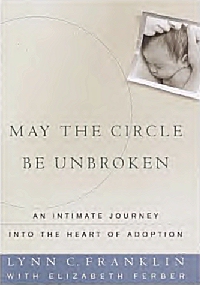
May the Circle Be Unbroken:
An Intimate Journey Into the Heart of Adoption
by Lynn Franklin
Harmony Books, 1998
She tells some of her own story, but without much emotion. When she takes the risk of getting into the details of her story, and her son’s, she is very engaging, but for the most part, in the first half of the book, she tends to remain somewhat distant, using a lot of quotes from other writers and individuals. She is now on the advisory board of Spence-Chapin (She states she was the first birth parent to be appointed there, although adoptive parents have been on the board for a long time), and she quotes adoption workers and therapists from this agency extensively. She gives a lot of facts and opinions about adoption from many viewpoints, rather than making this primarily her personal story.
As a reader and a therapist, who relinquished a son within a month of when she did, this writer was hoping for more of the author’s own viewpoint and experience, and found the first half of the book frustrating in the author’s distancing herself from her own feelings and memories, or at least not letting the reader in on them.
The second half of the book was more engaging, even though still. focusing more on others’ experiences, but in more detail and with fewer brief quotes. It may be that the author’s career as a literary agent influenced her approach, and the fact that she did not have other biological children. She does acknowledge that, after having a hysterectomy at age 40, she finally entered therapy to grieve her lost fertility and address her long-suppressed feelings. Her reunion took place several years after that, and has proceeded slowly as far as building a relationship with the son and his family.
Although the book jacket says she lives in New York “with her husband and son,” neither of them is mentioned. in the text, nor are any other personal relationships, other than brief references to her parents, sister, and niece. There is no clue as to when she married, whether this son is adopted or a stepson, nor does the reader learn much about the author’s personality, other than the lack of passion evident in the book. This will seem strange to the reader who has read other stories by birth mothers, birth fathers, adult adoptees, and adoptive parents, many of which are highly personal, emotional stories. This book may be more valuable to a first-time reader, or to professional therapists not already involved in adoption issues, than it is to veteran O.I. members who have read many books on adoption.
O.I. Member
Excerpted from the January 1999 edition of the Operation Identity Newsletter
© 1999 Operation Identity